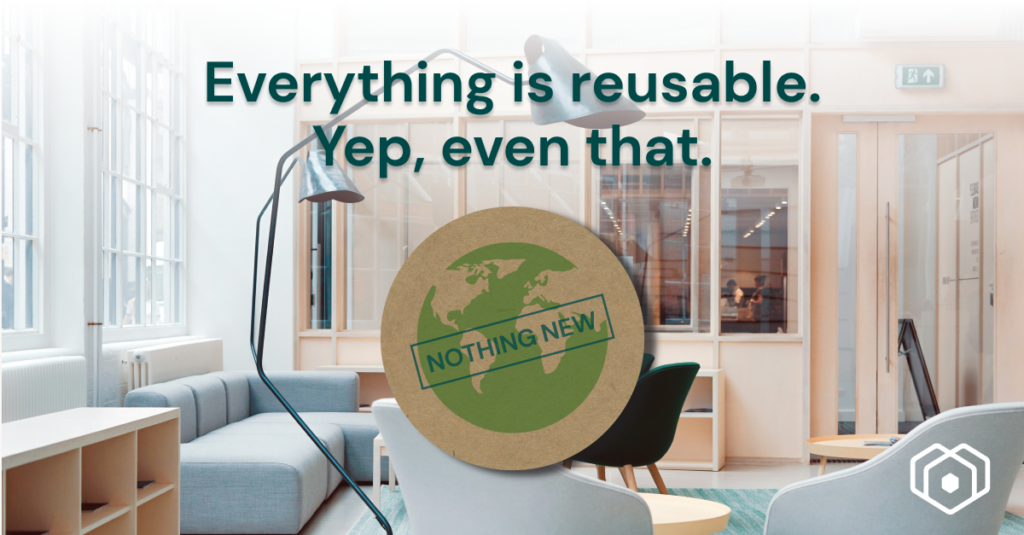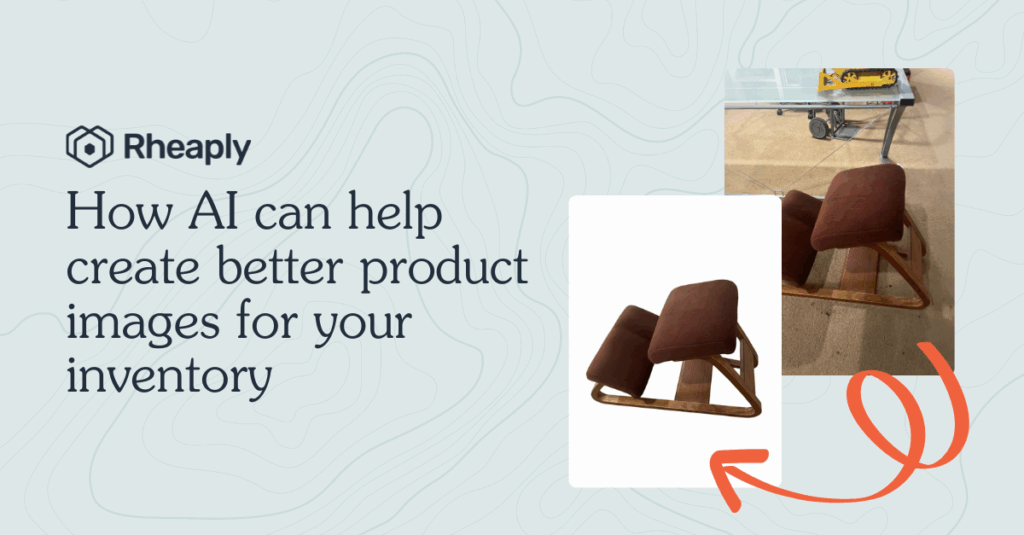
Facility management, real estate, and sustainability leaders: it’s time to face some difficult truths.
In the US, the furniture industry is estimated to be worth $15 billion, and yet 80% of all furniture will end up in a landfill.
In our modern workplaces, we face a lot of waste. But what if we didn’t have to?
At Rheaply, we know there’s a better way. We’re committed to finding sustainable, circular solutions to combat workplace waste problems. We believe that there is already an abundance of resources available in the world—and within your office spaces and facilities, at this very moment, right now!—and that a shift in mindset toward reuse will help businesses build a more sustainable future.
This is why we’re committing to Nothing New—because so much at our disposal isn’t disposable at all, and can be used again (and again).
So, what does Nothing New mean?
It means exploring what’s already available first, sourcing from your own inventory or a local refurbisher rather than buying brand new, tapping into a reuse marketplace to see if a neighboring business has what you’re looking for, or making what’s no longer of value to your business available to others. So that together, these items can experience their next life and avoid the landfill for as long as possible.
Feeling excited? So are we! Let’s look at a few reasons your business should embrace and participate in Nothing New.
The power of reuse
We’ve seen firsthand how reuse transforms both businesses and the world for the better. You and your company have a lot to gain by embracing a Nothing New philosophy:
- Save serious money
One of the most compelling reasons to adopt a Nothing New mindset is that it will save you money – and a lot of it. By reusing your existing resources that are tied up in storage or otherwise idle, you can reduce your business expenditure on purchasing new furniture and other office items. Last year, Rheaply customers saved more than $4 million by reusing what they already had.
- Operate more efficiently
Embracing a culture of reuse allows companies to operate more productively. When you commit to using what you already have, you’ll streamline your operations and reduce waste. One Rheaply customer cut down their furniture lead time for office refreshes from four months to two days with reuse.
- Build a more innovative, creative workplace
Reuse challenges businesses to think outside the box and come up with innovative solutions instead of relying on the way things have always been done. Finding new ways to repurpose existing resources can spark creativity and drive innovation within your organization.
- Boost company culture and morale
Employees are inspired and motivated when they see their organization making efforts to reduce waste and contribute to a better world. Reuse is a powerful way for facility management and corporate real estate teams, in particular, to dial into sustainability initiatives.
- Make a positive impact
Adopting a Nothing New mindset helps facility and real estate teams support their company’s Environmental, Social, and Governance (ESG) goals in unexpected ways. By reducing waste and landfill contributions and circulating the furniture, fixtures, and equipment you no longer need, you’ll have a direct impact on local communities and the environment.
3 ways you can implement sustainable practices in your workplace operations with Nothing New
As you can see, Rheaply is geeked on the transformative power reuse can have on how the working world operates. But we also know we can’t do it alone. The Nothing New mindset becomes more powerful as more businesses embrace it.
So we’re inviting you (yes, you!) to join us on this journey in committing to the Nothing New mindset.
Incorporate the following practices into your organization:
Have an office model or refresh project coming up? Challenge yourself to use what you already have. Take a closer look at your existing furniture and other items to see if they can be repurposed or rearranged to give your office a fresh, new look. By avoiding new purchases, you’ll save money and reduce waste.
When decommissioning assets, find a partner who will help you prioritize reuse over disposal. Before you discard any items, consider if they could still be of value to someone else. Make plans to repurpose assets internally or explore options for selling or donating them so that other businesses and nonprofits in your area can avoid purchasing new items unnecessarily.
Every business has one: A closet or storage room filled with assets you’re probably never going to use again. Instead of letting your surplus sit in storage indefinitely, explore opportunities to sell them and generate a new revenue stream (and cut down on those expensive storage costs to boot). You can also consider implementing a creative buy-back program to encourage customers to return used items for a discount on new purchases, taking an even bigger step forward into the circular economy.
Sustainable approaches to purchasing for when you must buy new
We’ve been talking a lot about committing to Nothing New, and while we believe this is the right thing to do for your business and the environment, we also know that sometimes, you have to buy things new. In industries like healthcare or other highly regulated sectors, safety and compliance standards might require it, and of course, safety comes first.
In the cases where reuse can’t be a first option, opt for other sustainable business practices:
- Use recycled materials: When purchasing new furniture or equipment, look for items made from reclaimed or recycled materials. Choosing products with recycled components helps reduce the demand for new resources and minimizes your environmental impact.
- Catalog and track your new items for future reuse: The moment you buy something new is a perfect opportunity to set yourself up for future reuse success. Consider your long-term vision for circulating and reusing items within your organization. Cataloging allows you to implement strategies for sharing equipment, furniture, or other resources across departments or projects to extend their life.
- Implement circular practices: If your business is involved in manufacturing new products, consider how you can help your customers plan for the full lifecycle of their purchase. Explore the possibility of establishing buy-back programs that let them return old items back to you when they no longer need them. This approach not only promotes a circular economy but also makes your production operations more sustainable from the start.
Nothing New success stories from reuse pros who’ve walked in your shoes
If you’re new to Nothing New, don’t sweat it. Plenty of folks have walked this path and have seen the success metrics you may need to cheer you on in your own journey.
Here are just a few examples from facility management, real estate, and sustainability leaders who have embraced this philosophy:
Allina Health
By implementing sustainable practices and reusing items whenever possible, Allina Health has saved thousands of dollars in procurement costs.
Read the case study →
Global Investment Banking Firm
A global leader in the investment banking industry had 1,600 high-end office chairs they needed to get rid of. They leaned on refurbishment partners and Rheaply’s network of nonprofits to find homes for all of the chairs—a donation worth more than $96,000.
Read the case study →
RUSH University Medical Center
By transforming a demolition project into an opportunity to reuse furniture, fixtures, and equipment, RUSH University Medical Center saved over $244,000 and diverted 53,000 pounds from the landfill.
Read the case study →
Let’s practice Nothing New together
Feeling inspired and wondering how you can bring the Nothing New mindset into your workplace? We’d love to help!
You can follow us on LinkedIn where we’ll be sharing weekly success stories from real companies who have leveraged reuse to run their businesses differently – and reaped the benefits as a result.
If you’re looking for specific ideas for how you can put reuse to work for your business, talk to our team about how you can implement a Nothing New mindset at your organization by using Rheaply’s platform.

